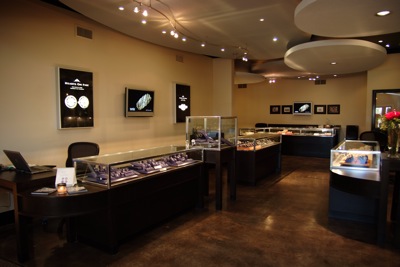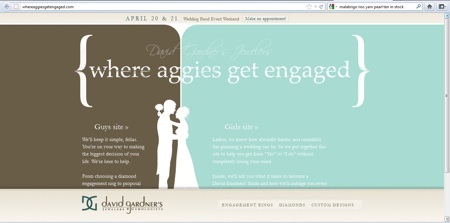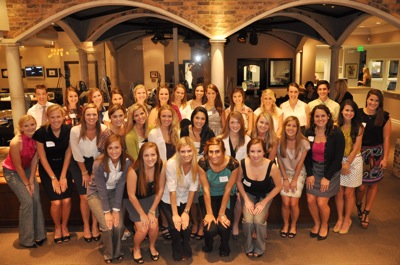Articles and News
DAVID GARDNER’S BOASTS TEXAS-SIZED BRIDAL BUSINESS | May 09, 2012 (0 comments)

This is the third of a three-part series about prestige jewelers who do well in the bridal category. Look for a special new Centurion PDF Book devoted to bridal, to be published and available in mid-May.
College Station, TX—A number of interesting, relevant, and surprising facts came to light when The Centurion spoke with David Gardner of David Gardner’s Jewelers about his successful and busy bridal sales category.
First, while the metro area that includes College Station already has about 200,000 residents, the student population from two local colleges, Texas A&M and Blinn College, adds another 68,000 potential customers—all at the right age to target for bridal jewelry. That’s a little surprising.
A little more surprising is the fact that David and his wife, Julia, read approximately 20 bridal magazines a month, including international publications.
But what’s most surprising is that Gardner Jewelers’ average engagement ring sale—typically to college students in their final years or those just graduated—is about $9,000, just shy of the average price of $10,000 many luxury jewelers reported in the recent Centurion 2012 Bridal Survey.
Of David Gardner’s $9,000 average, about $2,000 is spent for the semi-mount and the rest for the diamond.
How do college students—many who rely on loans and part-time employment just to pay tuition—afford a luxury engagement ring?
This inside look at a savvy prestige jeweler with a growing bridal business shows how.
The history. David Gardner handles the business side of the business, while his wife Julia and two employees, Sophia Sissamis and Tiffany Torregrossa, run the marketing aspect. Together, these two halves of this prestige jewelry business combine to offer customers of all ages a great ring buying experience.
Gardner’s store began as a community store, heavy in education and design. As students began to get married, they shopped at David Gardner’s Jewelers and liked what they found. According to Gardner, his store has only pursued the bridal market for about 12 years. The first line he bought was Scott Kay, at the first Centurion Show in 2001. The line caught his eye because he liked their advertisements. Afraid of the line’s higher price differential, Gardner investigated and found the price difference was in the marketing: they used great photography and showcased great romance. That was the start of his pursuit of the bridal market and his first bridal brand, which he still carries today.
The brands. Today Gardner carries 8-10 brands. They also have a full shop on the premises and do their own designs as well. Bridal makes up about 45% of their business. Of that, 10-15% is their own designs and 18-25% is from semi-mounts.
Among the bridal brands the jeweler carries are Precision Set, Hearts on Fire, Ritani, Christian Bauer, Efune, Tacori, Verragio, Memoire, Natalie K, and Scott Kay.
On the inventory side, center stones come from Gardner’s loose diamond inventory, which overlaps with several other sales categories. His semi-mounts and wedding band inventory is approximately 15-18% of inventory.
“We love the brands we have,” said Gardner. “We’re almost a test case for a bridal brand; we see how the college kids react to a brand. We see how the brands market themselves and how their salespeople work and how that’s changed their success and sell through.
According to Gardner, the success or failure of a brand depends heavily on the relationship between the brand’s sales representative and his or her relationship with the front line salespeople. “Companies that understand the sales reps need a great relationship with the sales gals and develop that do better. And it depends on service. If a brand has great service and delivers as promised, it will sell. If a brand is difficult to deal with, the sales gals will steer them away [to another brand].”
The brands that have been most successful at David Gardner’s Jewelers are those with “a tremendously connectable representative, and those that have embraced social media on their own. It used to be [the most successful brand was] who had the biggest ads in bridal magazines.”
But no longer: “It’s a game changer with social media,” he says. Gardner’s approach to connecting with his customers relies heavily on social media. “It’s constant,” he said. “Our strongest is Facebook right now. It’s suitable for visual images and our brands are on Facebook. Twitter is pretty successful.” Gardner says they are just getting started with Pinterest, finding out what capabilities for images it has and how they can connect to their customers using that technology.

The bridal area at David Gardner's Jewelers has enough space to serve several couples at a time, sitting far enough apart so they don't overhear each other.
The students. So just how does a college student afford a luxury engagement ring? With a lot of help.
Gardner tells of two recent sales. One was to a college student and one to a student just out of college. Each sale was approximately $15,000 total—and, as with many other aspects of Millennials’ lives, their parents are a big part of it. So is a helpful bank.
“The purchase price has a lot to do with their parents’ place in life,” Gardner said. “When the guy takes the new wife to Mom and Dad’s country club, the parents want to make sure she has the right ring. We see parents a lot as co-signers and Wells Fargo works well with us [on financing].”
On weekends, David Gardner’s Jewelers can handle five to seven couples at a time--some who come with their friends—all due to the store layout, which includes areas where college students can sit with their friends and browse. “We try to provide each with a one-on-one experience and we try to separate them a bit so they don’t overhear each other,” he said.

A seating area at David Gardner's Jewelers encourages students and their friends to relax and browse.
Selling the couple. “Selling a couple couldn’t be more different,” said Gardner, referring to the two halves that make up a ring-shopping duo. “I can still remember when the guys bought the ring by themselves,” says Gardner. “Not anymore. 90% of the selection is done by the female. If you don’t recognize that you’ll fall behind.”
He sees the female in charge of design and the male in charge of value.
“The female is the ultimate decision maker with no checkbook in hand. If you just have closer salespeople, they are out of the game,” he said. “Our bridal customer is basically going to buy from the person who can explain value. Not lowest price, but in the environment where they can get help making a decision based on value. That’s the guys’ deal.”
In Gardner’s experience, “Girls shop in groups. Guys are alone, with their gal, or including parental support. Groups of gals have been a common experience for at least five years. Sometimes it takes a while to figure which one, or ones, are actually ‘in the market.’ It can be a great deal of fun. They enjoy looking and experiencing all the possibilities. Guys are the opposite…[they want] three to five options, please!”

Grooms enter the David Gardner's bridal website on the left, brides on the right.
Gardner’s marketing reflects these differences between the two sexes. They have a traditional website, a Facebook page, and a site with a sense of humor targeted at the soon-to-be-engaged at www.whereaggiesgetengaged.com. This site features two ‘doors’ on the homepage, inviting a guest to click through to the girls or guys section of the site. Both sides of the site have tips for each sex. Here’s a sample from the guy’s side on the topic of proposals:
Top 5 Proposal Don'ts
- Don't hide the ring in her food. That's not the choked up you're looking for.
- Don't ask via JumboTron at an Aggie Football Game. Most women would prefer a little more intimacy.
- Don't get down on one knee while cooking and ask, "Will you marinade me?" That's just mean.
- Don't ask in front of family; the moment is about the two of you. Celebrate with the family after.
- Don't ask at someone else’s wedding. You might have seen this in a movie, but in reality you don’t want to upstage the happy couple's big day.
Top 5 Proposal Do's
- Do ask her parents for their permission or blessing. It's tradition and they will say yes.
- Do have a diamond ring. Diamonds possess the power to persuade.
- Do make it a surprise. No one in a 5-mile radius will ever forget that high-pitched "What are you doing what are you doing are you serious oh my gosh are you serious Yes Yes of course Yes!"
- Do drop to one knee. Yes, you will feel vulnerable and off-balance, but you'll get used to that.
- Do say, "Will you marry me?" This is how it's been done since the beginning of time, and who are you to rewrite history?
David Gardner’s Jewelers does sell to non-traditional couples, but they don’t promote it. “We don’t market to same sex couples,” said Gardner. “We live in an incredibly conservative area, but we do sell and service that market.”
The merchandise mix. “Platinum still is the desirable metal; still the big dog in the room,” he says. “18k is next, then 14k. We’re open [to what the market wants]. Two years ago, white was 99.9% of bridal market under 99 years. Yellow is now about 10-15%. Customers are looking for it, saying ‘is it OK?’ [to wear yellow gold].”
Gardner is seeing a yellow gold resurgence. A few months ago, he called each designer brand they carry and asked for several yellow rings. Not just the platinum or white rings made in yellow, but rings designed in yellow. And in their own shop, he did the same.
“Each design has its own characteristics,” said Gardner. “Not the same look in different metals. I’m absolutely fascinated because the yellow rings will look different than those in white. New color and new designs.” He says he’s seen less of colored gemstones since white has been popular, but he is looking forward to what’s coming next as different colored stones work well with yellow gold.
Gardner does take trade-ins and encourages customers to trade up. They do some buying, but they are not aggressive about it. Says he, “It’s not our passion.”
Student input and the future. Gardner has a student advisory council meeting about once a month. They feed the council dinner and drinks (for those of age) and pick their brains.
“Julia runs the Student Advisory Council meetings. She is absolutely amazing at getting them to open up, honestly, about the topics discussed. It’s a very necessary ingredient for this to be mutually beneficial. It's not just a social gathering,” enthused Gardner. “Pretty cool the way she does it!!”

David Gardner gets a lot of advice from his student advisory council.
The council keeps David Gardner’s Jewelers up to date on what the students think and how they shop. The interaction also keeps Gardner up on what’s new. “I’m not quite so sure that this next wave is [into] branding,” said Gardner of his recent interactions with the council. “I could be wrong. Our challenge is to stay relevant; if we can’t stay ahead of the curve, we try for at least close to the curve. This next group of students is not as impressed with the brands as the groups we saw a few years ago.”
Sophia Sissamis, part of the marketing department, agrees that the former council was more about brands. “The new one is more about design and value,” she said. She and Gardner aren’t talking any changes right now, but wanting to see what new trends settle for the future.
Retaining customers. “I think we’re terrible at that,” said Gardner candidly. “We make them work at that for us,” he said. “We have lots of customers that have been customers for 20 years, but it’s because the customer has made the effort. We don’t have an organized system to connect and maintain those customers. That’s an area of opportunity for us.”
He says many students buy rings from his store, then move to bigger cities. It can be challenging to keep in touch. “There’s a drought of jewelry after the bridal purchase,” said Gardner. “They need to buy a house, then kids, etc. Jewelry is not a priority; they have to get through all their ‘firsts.’ Even if you stay connected, they may not be buying. When things calm down, then they become a customer again.”
Oh, and about those bridal magazines? How often does Gardner really read bridal magazines? “Way more than I’d like to admit,” says David. “Julia and I look at 20 magazines a month, including some out of Europe. The international ones are at the forefront of fashion and color changes (not necessarily bridal jewelry). The American market is very independent in their jewelry designs. We try to read them all; we want to see what our customers are seeing. “
There’s no doubt that David Gardner finds the bridal market fascinating and that his marketing team really knows what they are doing when to bring in customers.
“Bridal is a sport, things are changing, teams are changing and it’s fun trying to win. Our customers want to have that touch and feel experience and see our selection and experience our service. Once they come in, it’s our sale to lose,” says Gardner. “It’s lots of fun."







